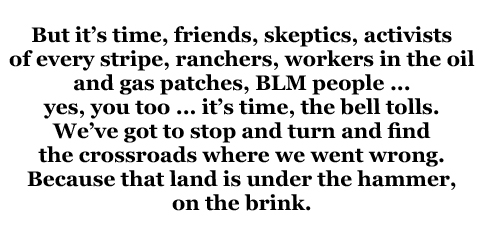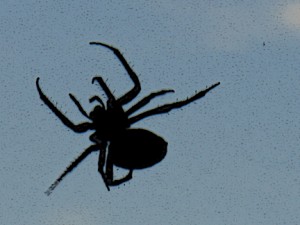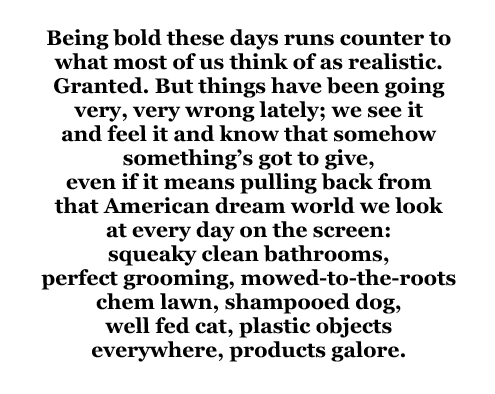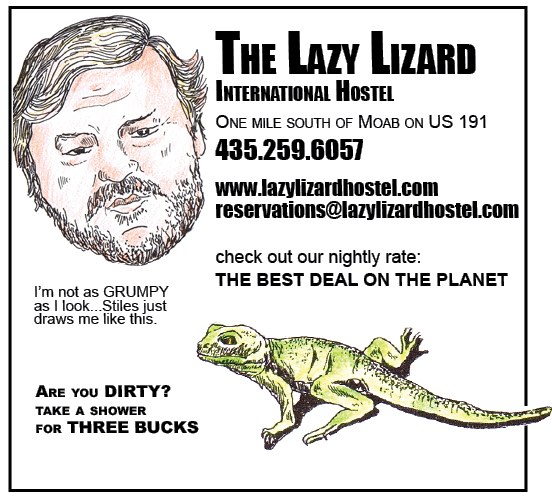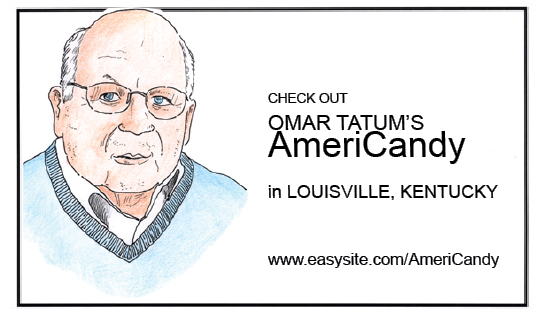Yesterday I happened to be looking through the open back doorway of the cabin. A housefly’s flight came to an abrupt stop and there came the barn spider on its invisible line. Reaching the fly, the spider wrapped it with a few strokes and then subsided, legs tucked in, motionless. I imagined it quietly taking in body fluids of the fly. Next day I went to its webwork and touched the upper right anchor. Immediately the spider shifted, aimed itself at my finger. I jerked back, the spider turned in one smooth movement to resume its original position, alert status ended, tucked again into a spider’s pond of calm, not that I know what that is.
Usually a calm for us modern humans seems to be a sort of affair: partial, frets and concerns not quite gone. One of those took me today as I looked through that same doorway, back to another place, other times, the Red Desert of Wyoming. I was with a bird watcher friend and Grant Hagen, Jackson Hole native and wonderful animal artist. We wandered up Steamboat mountain, in no hurry, pooling our fragmentary knowledge of plants and rocks, animals and history; patrolling cliff tops, accompanied by a pair of screaming prairie falcons, finding what we decided might very well be the buffalo drop that Dave Love, Wyoming geologist, had mentioned.
We looked out from time to time at one of North America’s grand far-ranging landscapes. The scene shifted to more recent times, Steamboat again, with three veteran Red Desert defenders: Tom Bell, wildlife biologist and founder of High Country News, Mac Blewer, outreach director of Wyoming Outdoor Council, and Marian Doane, a most knowledgeable woman who can read the range. Neither of those days were like quiet dreams nor were they times of fret; they were hour after hour of real living. You know what I mean, I won’t dissect it.
The Red Desert intrudes here because it does, that’s all. I’ve mentioned it before, that great country that merges with other high plains regions spreading north past the Big Horns into Montana, south into Colorado, east toward the Medicine Bows. But it’s time, friends, skeptics, activists of every stripe, ranchers, workers in the oil and gas patches, BLM people … yes, you too … it’s time, the bell tolls. We’ve got to stop and turn and find the crossroads where we went wrong. Because that land is under the hammer, on the brink.
We all have our special places … home towns, streets, city blocks, mountains, valleys, desert oases … places that can’t be violated without a very damn good reason, such as life, liberty and the pursuit of happiness. Places where the bottom line of Exxon or Mobil or BP or WalMart has no standing. For me the Red Desert is not only one of those, it has become a vibrant set of instructions written on the land, directions to what is happening elsewhere.
So hear me out. The crossroad where we went wrong was our backing away from linking to other groups to fight for a rigorous and radical overhaul of federal and state energy policy. Instead, the prime focus, money and bombast were expended on defense of the Arctic National Wildlife Refuge, a part of the circumpolar arctic, all of which is now, and will be (refuge included) in the gunsights of fossil fuel corporations worldwide.
Other lands in the Americas, Asia, Africa are targeted too. It was too easy to think in that small-scale, piecemeal activist cage known as the art of the politically possible. We could have thrown down a gauntlet, insisted on a a wide-ranging ecological/political ground on which to struggle. We could have been talking a lot more to each other, making contacts, building confidence, breaking barriers, building a truly independent grassroots base. Is it too late, to advance the art of democracy.?
Hard row to hoe? Sure, but maybe not quite so tough, once we get into the swing of it, and once we take seriously the fact that the earth does not wait on us, is not under our command, has its own time scale. What that means right now is a huge gap between what has to be done and what we take to be possible. Take the Kerry campaign. No, let’s not. Let’s look at one of those gaps, neatly summarized by Ross Gelbspan.
“The scientists (who had previously reported to a 1995 United Nations panel) subsequently concluded that to stabilize our climate requires humanity to cut its use of coal and oil by 70 percent in a very short time. In contrast, the Kyoto Protocol calls for industrial countries to cut aggregate emissions by just 5.2 percent by 2014.” The Nation, Aug. 15-23, 2004).
Our nation won’t even abide by the pitiful, embarrassing, totally ridiculous Kyoto goal. You see what I’m driving at? A bold, overarching strategy for rescue of the Red Desert and other places at risk would link directly to a bold and realistic strategy for moderating global warming.
Being bold these days runs counter to what most of us think of as realistic. Granted. But things have been going very, very wrong lately; we see it and feel it and know that somehow something’s got to give, even if it means pulling back from that American dream world we look at every day on the screen: squeaky clean bathrooms, perfect grooming, mowed-to-the-roots chem lawn, shampooed dog, well fed cat, plastic objects everywhere, products galore.
What could be more realistic than a look behind those fake scenes— Poison brew from PVC plastic manufacture; leaks and spills on the Alaska pipeline; radioactive storage in Navaho country; cascading consequences of damming the Colorado river; criminal waste of two of earth’s most precious materials: oil and water. And who’s counting war damage? It’s a time to be bold; might be too late; wouldn’t that be sad? Who could we blame?
I was in the midwest during the Reagan apotheosis. Myriads of flags, yellow ribbons on vehicles, power poles, houses. But behind all that, another presence, the dry earth.. Newspapers, printing without fail the national boilerplate, also spent many column inches, and photos too, on the drought. Government offices were prime sources of news; Water Districts, Bureau of Reclamation, Geological Survey, Bureau of Land Management, Agricultural Extension … wherever some hope or help might be found.
Droughts come and go. We can’t engineer them out of existence. What we can do is adapt, by drastic measures, which we are not taking, because we’ve been trained to think only within the bounds of “Get the government off our backs.” But government is absolutely essential and the arid land crisis is proving that. The real issue is not what, but who. The art of the politically possible, a pathogen, most virulent in the Beltway and media-land, but its spores spread across the land, infecting the rest of us who live with real consequences. We’re hamstrung by fear of stepping over the line; we’re afraid of being labeled radical, naive, utopian, revolutionary, or worse.



